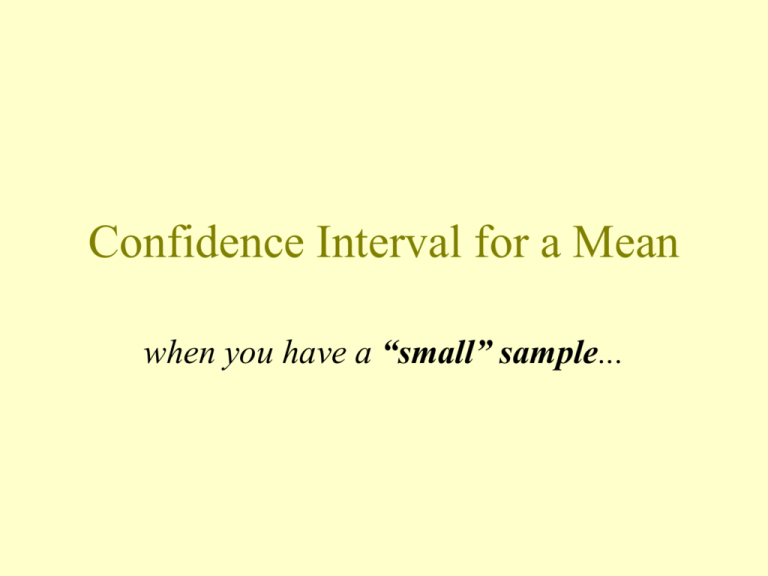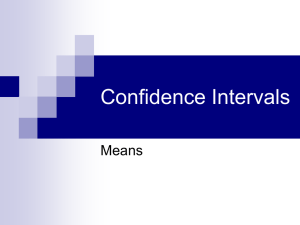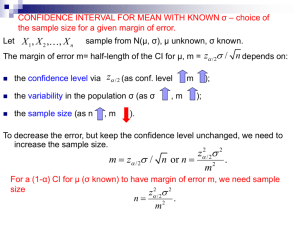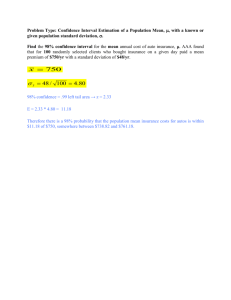Confidence Interval for Mean
advertisement

Confidence Interval for a Mean when you have a “small” sample... As long as you have a “large” sample…. A confidence interval for a population mean is: s x Z n where the average, standard deviation, and n depend on the sample, and Z depends on the confidence level. Example Random sample of 59 students spent an average of $273.20 on Spring 1998 textbooks. Sample standard deviation was $94.40. 94.4 273.20 1.96 273.20 24.09 59 We can be 95% confident that the average amount spent by all students was between $249.11 and $297.29. What happens if you can only take a “small” sample? • Random sample of 15 students slept an average of 6.4 hours last night with standard deviation of 1 hour. • What is the average amount all students slept last night? If you have a “small” sample... Replace the Z value with a t value to get: s x t n where “t” comes from Student’s t distribution, and depends on the sample size through the degrees of freedom “n-1”. Student’s t distribution versus Normal Z distribution T-distribution and Standard Normal Z distribution 0.4 Z distribution density 0.3 0.2 T with 5 d.f. 0.1 0.0 -5 0 Value 5 T distribution • Shaped like standard normal distribution (symmetric around 0, bell-shaped). • But, t depends on the degrees of freedom “n-1”. • And, more likely to get extreme t values than extreme Z values. Graphical Comparison of T and Z Multipliers 5 4 T with 5 df 3 2 Z distribution 1 0 0.90 0.92 0.94 0.96 0.98 Cumulative Probability 1.00 Tabular Comparison of T and Z Multipliers Confidence t value with Z value level 5 d.f 2.015 1.65 90% 2.571 1.96 95% 4.032 2.58 99% For small samples, T value is larger than Z value. So,T interval is made to be longer than Z interval. Back to our example! Sample of 15 students slept an average of 6.4 hours last night with standard deviation of 1 hour. Need t with n-1 = 15-1 = 14 d.f. For 95% confidence, t14 = 2.145 s 1 x t 6.4 2.145 6.4 0.55 n 15 That is... We can be 95% confident that average amount slept last night by all students is between 5.85 and 6.95 hours. Hmmm! Adults need 8 hours of sleep each night. Logical conclusion: On average, students need more sleep. (Just don’t get it in this class!) T-Interval for Mean in Minitab T Confidence Intervals Variable Comb N 89 Mean 2.011 StDev 1.563 SE Mean 0.166 95.0 % CI (1.682, 2.340) We can be 95% confident that the average number of times a “Stat-250-like” student combs his/her is between 1.7 and 2.3 times a day. T- interval in Minitab • • • • • • Select Stat. Select Basic Statistics. Select 1-Sample t… Select desired variable. Specify desired confidence level. Say OK. What happens as sample gets larger? T-distribution and Standard Normal Z distribution 0.4 Z distribution density 0.3 T with 60 d.f. 0.2 0.1 0.0 -5 0 Value 5 What happens to CI as sample gets larger? x Z x t s n s n For large samples: Z and t values become almost identical, so CIs will be almost identical. Example Random sample of 64 students spent an average of 3.8 hours on homework last night with a sample standard deviation of 3.1 hours. Z Confidence Intervals The assumed sigma = 3.10 Variable Homework N Mean 64 3.797 StDev 3.100 95.0 % CI (3.037, 4.556) T Confidence Intervals Variable N Mean Homework 64 3.797 StDev 3.100 95.0 % CI (3.022, 4.571) One not-so-small problem! • It is only OK to use the t interval for small samples if your original measurements are normally distributed. • We’ll learn how to check for normality. Strategy • If you have a large sample of, say, 30 or more measurements, then don’t worry about normality, and calculate a t-interval. • If you have a small sample and your data are normally distributed, then calculate a t-interval. • If you have a small sample and your data are not normally distributed, then stay tuned.








